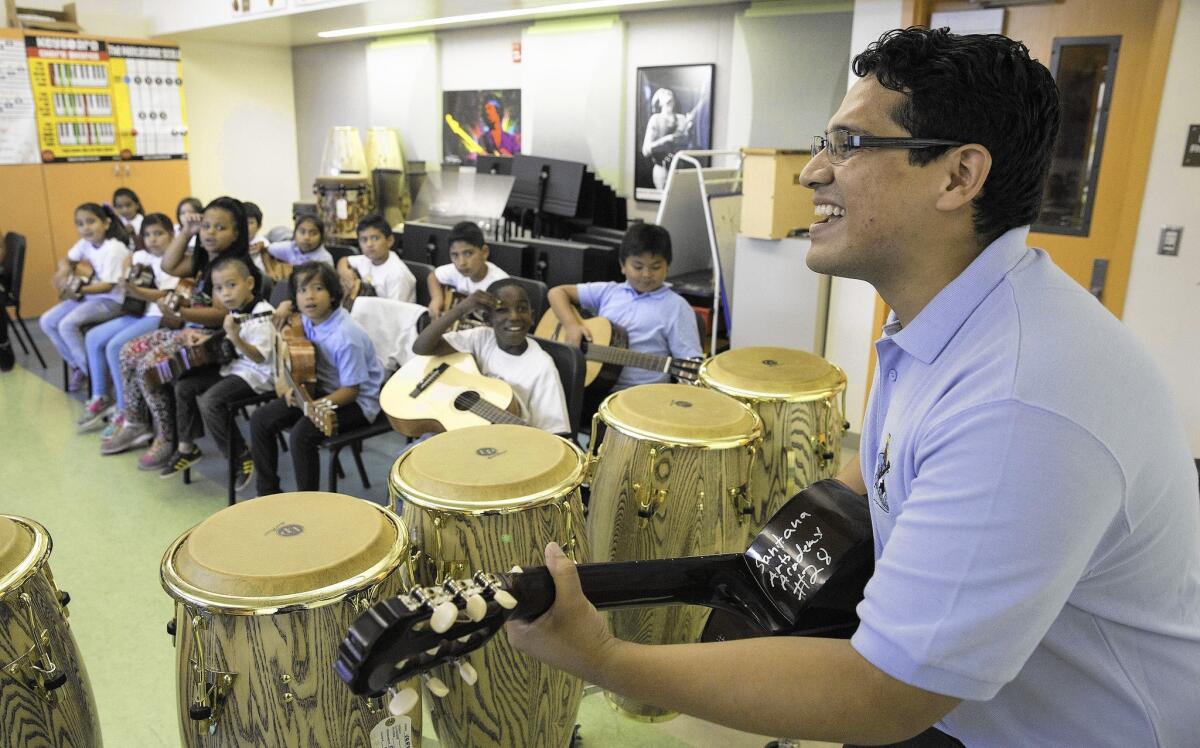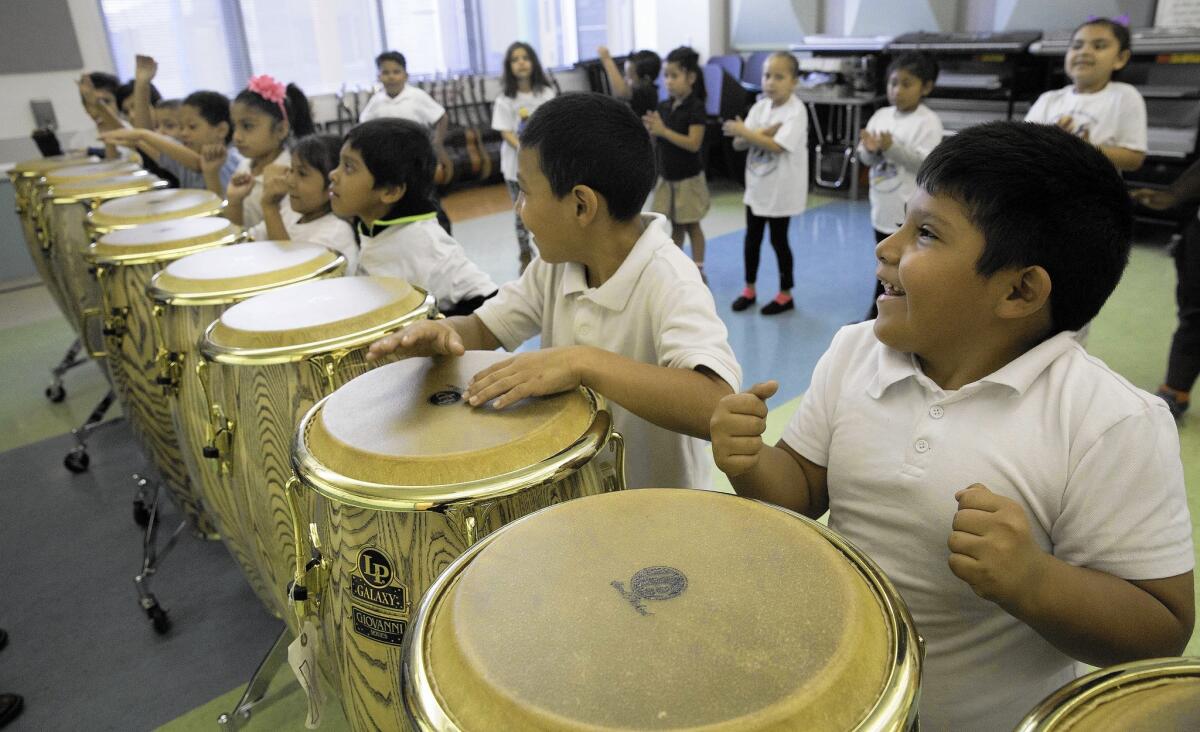Only 35 L.A. public schools get an A in supporting the arts

Normandie Avenue Elementary Principal Gustavo Ortiz worries that he canât provide arts classes for most of the 900 students at his South Los Angeles school.
Not a single art or music class was offered until this year at Curtiss Middle School in Carson.
At Carlos Santana Arts Academy in North Hills, a campus abuzz with visual and performing arts, the principal has gone outside the school district for help. A former professional dancer, she has tapped industry connections and persuaded friends to teach ballroom dancing and other classes without pay until she could reimburse them.
Budget cuts and a narrow focus on subjects that are measured on standardized tests have contributed to a vast reduction of public school arts programs across the country. The deterioration has been particularly jarring in Los Angeles, the epicenter of the entertainment industry.
The Los Angeles Unified School District is discovering the extent of those cuts as it seeks to regain the vibrancy that once made it a leader in arts education. For the first time, L.A. Unified in September completed a detailed accounting of arts programs at its campuses that shows stark disparities in class offerings, the number of teachers and help provided by outside groups.
Arts programs at a vast majority of schools are inadequate, according to district data. Classrooms lack basic supplies. Some orchestra classes donât have enough instruments. And thousands of elementary and middle school children are not getting any arts instruction.
A Los Angeles Times analysis that used L.A. Unifiedâs data to assign letter grades to arts programs shows that only 35 out of more than 700 schools would get an âA.â Those high-performing schools offered additional instruction through community donations, had more teachers and a greater variety of arts programs than most of the districtâs campuses.
The Timesâ analysis shows that elementary school arts programs in poor neighborhoods have been the hardest hit despite the districtâs decades-long attempt to close the gap between low-income and more affluent students.
A key factor contributing to the disparities is the ability of schools in more affluent areas to tap foundations and community members for help as district funds dwindled. Elementary schools that supplemented arts education at their campuses with outside resources had an average poverty rate of 60%, well below the district average. On the other end, at campuses that relied solely on district funding for the arts, 82% of students were low-income.

Thirteen middle and high schools had more than seven full-time teachers, while others had no programs at all. At a majority of elementary schools, an arts teacher visits one or two times a week. Only four elementary schools â West Vernon, Magnolia, Bonita Street and 49th Street Elementary â had an arts teacher five days a week, according to district data.
âI feel real guilty because my kids go to schools where an art teacher and a music teacher are there five days a week,â said Ortiz, who pointed to Normandieâs limited budget. âI come here and I canât give the kids what my own kids get. It just tears me up. Itâs such an inequity.â
Arts education was not meant to be a luxury in California.
State law requires that schools provide music, art, theater and dance at every grade level. But few districts across the state live up to the requirement.
California is among the states with the strongest policies on arts education. But Sandra Ruppert, who directs the nonprofit Arts Education Partnership in Washington, D.C., said the state faces a âpolicy paradoxâ because of weak or uneven implementation.
âThe state policy landscape tells you one thing, but then you really have to look at the district and, in many cases, you have to look at the individual schools,â Ruppert said. âYou can have two schools that are very similar demographically and have very different arts offerings.â
State Sen. Ben Allen (D-Santa Monica), chairman of the stateâs Joint Committee on the Arts, said that as the economy improves, state and local leaders must begin talking about reinvestment. This week his panel will hold a hearing in Beverly Hills focused on improving arts education.
âThey have requirements under law, so the question is how do we work with our school districts to make sure that they are able to figure out a way to get in compliance and provide good-quality arts education to our kids?â Allen said.
The state policy landscape tells you one thing, but then you really have to look at the district and, in many cases, you have to look at the individual schools.
— Sandra Ruppert, director of the nonprofit Arts Education Partnership in Washington, D.C.
At L.A. Unified, eight out of every 10 elementary schools donât have the programs needed to meet state requirements, The Timesâ analysis shows.
Only about a quarter of the students at Normandie take some form of arts classes. And just 60 get the opportunity to learn how to play an instrument.
The numbers donât seem fair to sixth-grader Charles Johnson, who said music is the reason he looks forward to school. He learned to play the violin, guitar, drums, bass and piano at Normandie. He said music helped him adjust to the loss of his baby sister and the death of his grandfather.
âMusic can help in lots of ways,â Charles said. âIt can help you with pushing away from problems, being free and feeling relaxed.â
The lack of arts programs at the middle school Charles was slated to attend contributed to his motherâs decision to send him to a charter school. That school, however, has only a basic after-school arts program, so now she is left searching for other options.
Research shows that arts education bolsters student achievement and contributes to stronger participation in school activities. Low-income students who participated in arts rich programs had better grades and higher rates of college enrollment and graduation than those who had little or no involvement, according to a 2012 study by the National Endowment for the Arts.
In a resolution passed three years ago, the L.A. Board of Education pointed to such studies and said cuts to arts programs âexacerbate inequality and the opportunity gapâ for low-income and minority students. It promised to restore funding within five years.
At its height in 2007, the district invested $32 million in arts education and drew an additional $46 million in grants from the state. That funding plummeted to $19 million during the recession and many campuses were left to fend for themselves. L.A. Unified bolstered its arts budget to $26.5 million this year and hired 45 teachers.
District arts director Rory Pullens, the former head of school at the prestigious Duke Ellington School of the Arts in Washington, D.C., used the survey results this year to direct additional funding and teachers to campuses with the fewest resources. Before then, Pullens said, the district had no way of assessing the needs and disparities at campuses.
Pullens also is encouraging involvement from Hollywood. He is visiting movie studios and production companies and asking them to âadoptâ a school, offering to simplify tax deductions for donations, and has hired an employee to publicize contributions. The first to sign on were Sunset Bronson and Sunset Gower studios. Additional partnerships are being negotiated.
At first, Pullens said some companies were reticent because of negative perceptions of the district. One studio executive told him that the company wanted to be associated with âsomething positive.â But Pullens said more Hollywood studios are lending a hand as they realize the district is starting to reinvest.
âThey want to see that the entity is doing something for themselves,â Pullens said.
NEWSLETTER: Get the dayâs top headlines from Times Editor Davan Maharaj >>
Grammy Award-winning trumpet master Wynton Marsalis has long pushed for increased arts education. His organization works with 15 L.A. schools to produce Jazz for Young People concerts.
But Marsalis said that at times, the slow pace of change leaves him feeling as if he is teaching a class to students who donât want to learn.
âFor some reason, we are unable to understand the importance of our identity as expressed through the arts,â Marsalis said. âWe tend to be very pragmatic and bottom-line-oriented. Everything is a metric, and there are things deeper than metrics. The soul is deeper than a metric.â
Nearly two decades after former state schools Supt. Delaine Eastin called the decline of arts programs in California a silent crisis, educators and community leaders across the state are still struggling to make significant widespread progress.
The stateâs new funding formula for public schools â which allocates more money for low-income students and allows greater flexibility in determining how to spend it â has raised hopes among advocates that districts will begin restoring money for the arts.
Districts in wealthier parts of the state â Beverly Hills, Marin County and Davis â have continued to invest in arts education by tapping community members, parents and, in some cases, taxpayers. Those efforts helped fill the gap left by reduced state funds but extended inequities, according to a report issued this year by an arts education coalition formed by state Supt. of Public Instruction Tom Torlakson.
Curtiss, in Carson, opted to spend limited dollars on Spanish and science electives rather than the arts.
The middle school was among more than a dozen campuses that were assigned a teacher this year after the district discovered they had no arts programs.
Curtiss now has a choir teacher but remains far behind the level of arts education provided at other district schools. âItâs something we wanted, but we just didnât have the money,â Principal Gina Russell-Williams said.
Carlos Santana Arts Academy â the highest-rated elementary school for arts classes â is among the few exceptions.
More than 90% of the schoolâs students are low-income, so Principal Leah Bass-Baylis, a former professional dancer, turned to business and personal contacts to provide classes that she could not offer with limited district money.
Bass-Baylis, who was previously the assistant principal at Millikan Middle School, which has a performing arts magnet and where 36% of students are low-income, said she quickly learned the challenges of leading a less-affluent campus.
âWhen you donât have money, you have to count on people to do things out of the kindness of their own hearts and you say, âI promise Iâll pay you,ââ she said.
Pullens said the district is working to change that dynamic but is still far from the $80 million it would need to ensure that elementary students receive an arts education in every grade. The price tag is harder to determine at secondary schools, which manage their own arts budgets.
âEven with this increase in funding, we havenât really restored the arts programs to where they were initially,â Pullens said. âWeâre still underwater. Instead of being 100 feet underwater, weâre 50 feet underwater but guess what, thatâs still drowning.... You have to get your head above water, and weâre not there yet.â
Twitter: @zahiratorres
Twitter: @ryanvmenezes
ALSO
Nearly 500 arrested at electronic music festivals in Pomona, San Bernardino
28 deaths from West Nile virus confirmed in California so far in 2015
Get out those fall clothes, L.A.: Temperatures could drop by 20 degrees
More to Read
Sign up for Essential California
The most important California stories and recommendations in your inbox every morning.
You may occasionally receive promotional content from the Los Angeles Times.












